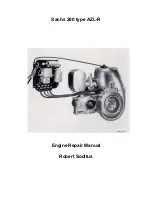
In case intention is to operate on low sulphur fuel it is beneficial to install double settling tanks
to avoid incompability problems.
To ensure sufficient time for settling (water and sediment separation), the capacity of each
tank should be sufficient for min. 24 hours operation at maximum fuel consumption.
The tanks should be provided with internal baffles to achieve efficient settling and have a
sloped bottom for proper draining.
The temperature in HFO settling tanks should be maintained between 50°C and 70°C, which
requires heating coils and insulation of the tank. Usuallly MDF settling tanks do not need
heating or insulation, but the tank temperature should be in the range 20...40°C.
6.3.3.2
Day tank, HFO (1T03) and MDF (1T06)
Two day tanks for HFO are to be provided, each with a capacity sufficient for at least 8 hours
operation at maximum fuel consumption.
A separate tank is to be provided for MDF. The capacity of the MDF tank should ensure fuel
supply for 8 hours.
Settling tanks may not be used instead of day tanks.
In case intention is to operate on different fuel qualities (low sulphur fuel) it is beneficial to
install double day tanks to avoid incompability problems.
The day tank must be designed so that accumulation of sludge near the suction pipe is
prevented and the bottom of the tank should be sloped to ensure efficient draining.
HFO day tanks shall be provided with heating coils and insulation. It is recommended that the
viscosity is kept below 140 cSt in the day tanks. Due to risk of wax formation, fuels with a
viscosity lower than 50 cSt at 50°C must be kept at a temperature higher than the viscosity
would require. Continuous separation is nowadays common practice, which means that the
HFO day tank temperature normally remains above 90°C.
The temperature in the MDF day tank should be in the range 20...40°C.
The level of the tank must ensure a positive static pressure on the suction side of the fuel feed
pumps. If black-out starting with MDF from a gravity tank is foreseen, then the tank must be
located at least 15 m above the engine crankshaft.
6.3.3.3
Starting tank, MDF (1T09)
The starting tank is needed when the engine is equipped with the engine driven fuel feed pump
and when the MDF day tank (1T06) cannot be located high enough, i.e. less than 1.5 meters
above the engine crankshaft.
The purpose of the starting tank is to ensure that fuel oil is supplied to the engine during
starting. The starting tank shall be located at least 1.5 meters above the engine crankshaft.
The volume of the starting tank should be approx. 60 l.
6.3.3.4
Leak fuel tank, clean fuel (1T04)
Clean leak fuel is drained by gravity from the engine. The fuel should be collected in a separate
clean leak fuel tank, from where it can be pumped to the day tank and reused without
separation. The pipes from the engine to the clean leak fuel tank should be arranged continuosly
sloping. The tank and the pipes must be heated and insulated, unless the installation is designed
for operation on MDF only.
The leak fuel piping should be fully closed to prevent dirt from entering the system.
6.3.3.5
Leak fuel tank, dirty fuel (1T07)
In normal operation no fuel should leak out from the components of the fuel system. In
connection with maintenance, or due to unforeseen leaks, fuel or water may spill in the hot
6-12
Wärtsilä 20 Product Guide - a13 - 6 September 2016
Wärtsilä 20 Product Guide
6. Fuel Oil System
Содержание WARTSILA 20
Страница 1: ...W RTSIL 20 PRODUCT GUIDE...
Страница 34: ...This page intentionally left blank...
Страница 42: ...This page intentionally left blank...
Страница 86: ...This page intentionally left blank...
Страница 92: ...This page intentionally left blank...
Страница 124: ...This page intentionally left blank...
Страница 140: ...This page intentionally left blank...
Страница 154: ...This page intentionally left blank...
Страница 160: ...This page intentionally left blank...
Страница 172: ...This page intentionally left blank...
Страница 175: ......
Страница 176: ......
Страница 177: ......
















































